ff97d19782da7054f9b3eae152e76137.ppt
- Количество слайдов: 89

Computer Architecture I: Digital Design Dr. Robert D. Kent Computer Architecture Machine & Assembly Language Programming

Review • We adopted and discussed Mano’s model of computer architecture (Mano – Chapter 5) • Instruction Set • Control architecture • Instruction processing – – Register access Memory access (Direct, Indirect) I/O access Interrupts • Timing sequences of microoperations

Considering the next problem in design • Now that we know how instruction sets may be formulated, and how individual instructions are executed – How are programs expressed? • Logical sequences of machine coded instructions – How is the notion of “high level” programming supported? • Assembly language – How are “high level” languages translated to machine code? • Assembler translator

Goals • We conclude our lecture series by considering computer organization – Combining the CPU, Memory and Bus architectures together with logic programming • In this final sequence of lectures slides we discuss some issues related to programming (Mano – Chapter 6) – Assembly language – Assembler translators – Programming examples

Stored programs • A stored program is a set of instructions and data expressed in binary language, stored in non-volatile (ie. disk storage) memory • Programs can be executed only from Memory. – Thus, a program must be loaded from disk to RAM in order to execute it. – Loaded programs are called processes. – Individual instructions must be transferred to the CPU where they are executed, using data that must be obtained from either CPU registers or RAM • A process is executed by executing each individual instruction that, collectively, fulfill the intentions of the programmer.

Instruction Hierarchy • The computer is engineered to support a reasonable number of independent instructions – Uses a hierarchical scheme (1+3+12 scheme) • Op. Code – 3 bits – supports 8 unique codes – 0 -6 (instructions) – 7 (toggle) • Mode – 1 bit – supports 2 addressing modes – I = 0 Direct addressing – I = 1 Indirect addressing • Special Case : : Op. Code = 7 (toggle) PLUS Mode bit (I) – Use 12 bits of Address field to specify additional instructions 15 14 IR I 12 11 Op. Code 0 Address / Op. Code extension bits

Instruction Hierarchy • Mano’s instruction set consists of 25 instructions: Instruction Op. Code (0 -6) Op. Code (7) Direct (I=0) Indirect (I=1) Direct (I=0) 4 bit code 0 AND 1 ADD 2 LDA 3 STA 4 BUN 5 BSA 6 ISZ 4 bit code 8 AND 9 ADD A LDA B STA C BUN D BSA E ISZ 16 bit 7800 7400 7200 7100 7080 7040 7020 7010 7008 7004 7002 7001 7 Indirect (I=1) code 16 bit code CLA F 800 INP CLE F 400 OUT CMA F 200 SKI CME F 100 SKO CIR F 080 ION CIL F 040 IOF INC SPA 6 SNA SZE 12 HLT

Programming the basic computer • Remind yourself that the only language that the computer logic understands is Machine Language – Expressed in binary (voltage values in gates and on wires) • From the perspective of the machine we have previously constructed, consider the example program: Location Instruction Code 0 0010 0000 0100 1 0000 0101 10 0011 0000 0110 11 0111 0000 0001 100 0000 0101 0011 101 1111 1110 1001 110 0000 Although the computer may understand this Still considering ? it program encoding, is very difficult for humans to understand what is intended, or how it is to be carried out.

Programming the basic computer • The example is somewhat easier to understand if we Symbolic Operations makes it easier replace binary stringsunderstand the intensional logic. to by hexadecimal strings Expressing data in machine language format, easier recognition of Operation both conceptual especially arithmetic data, requires Codesof Determining address locations understanding and instructions) remains data (or technical skill in translating easier recognition of Address references from one representation (eg. decimal) to another difficult. (hexadecimal, octal, binary). – Permits – Data representations are compacted Location Instruction Code Mnemonic Decimal Data 0 2004 LDA 004 1 1005 ADD 005 2 3006 STA 006 3 7001 HALT 4 0053 First op 83 5 FFE 9 Second op -23 6 0000 Store sum 0 (Initial)

Programming the basic computer • The previous program demonstrates several important requirements in designing a non-binary oriented programming language suitable for human programmers. – Being able to identify each operation by its mnemonic. – Being able to represent address locations symbolically • To avoid having to carefully and tediously determine actual values of addresses (which may change many times during program creation) • To permit limited degrees of program relocatability in memory – Being able to define data storage locations as named variables • With limited data type attribution • With option to assign initial values in various formats

Instruction Code Programming the basic computer Location ORG 0 /Origin of program at location 0 LDA A /Load data at A into AC • Mano introduces a well-formed, complete Assembly ADD B /Add data at B to AC Language. STA C /Store AC data at C – It provides all essential requirements for humans HLT /Halt the computer – It is easily translated to binary format using an Assembler. A, DEC 83 /Decimal data (operand) initialized B, DEC -23 /Decimal data initialized C, DEC 0 /Decimal data (initial 0) Location Instruction Code Mnemonic Decimal Data END /End of symbolic program 0 2004 LDA 004 1 2 3 4 1005 3006 Assembly 7001 Language Program 0053 ADD 005 STA 006 HALT First op 83 5 FFE 9 Second op -23 6 0000 Store sum 0 (Initial)

Assembly Language • Assembly language programs are written using statements with three fields – Label : : A symbolic address - a string delimited by a comma ‘, ’ – Instruction : : either a machine instruction or a pseudo-instruction – Comment : : Programmer comments not relevant to program logic Label A, B, C, Instruction ORG LDA ADD STA HLT DEC DEC END 0 A B C 83 -23 0 Comment /Pseudo-instruction /Machine instruction, symbol reference /Machine instruction /Pseudo-instruction with label field /Pseudo-instruction

Assembly Language – Symbolic Addresses • Symbolic addresses, or Labels, – Consist of strings delimited by a comma ‘, ’ ! – Consist of 1, 2 or 3 characters only ! – May be preceded by white spaces. Label A, BB, CCC, Instruction ORG LDA ADD STA HLT DEC DEC END 0 A BB CCC 83 -23 0 Comment /Pseudo-instruction /Machine instruction, symbol reference /Machine instruction /Pseudo-instruction with label field /Pseudo-instruction

Assembly Language – Comments • Comments – – Begin with a slash ‘/’ character ! All characters after the slash are part of the comment Comments are terminated by the new line character(s) ! May be preceded by white spaces. Label A, B, C, Instruction ORG LDA ADD STA HLT DEC DEC END 0 A B C 83 -23 0 Comment /Pseudo-instruction /Machine instruction, symbol reference /Machine instruction /Pseudo-instruction with label field /Pseudo-instruction

Assembly Language – Instructions (0) • There are three types of Instructions – Memory Reference Instructions (MRI) – Non-Memory Reference Instructions (non-MRI) • Register reference • Input/Output reference – Pseudo-Instructions (soo-do, or syu-do) Label A, B, C, Instruction ORG LDA ADD STA HLT DEC DEC END 0 A B C 83 -23 0 Comment /Pseudo-instruction /Machine instruction, symbol reference /Machine instruction /Pseudo-instruction with label field /Pseudo-instruction

Assembly Language – Instructions (1) • Memory Reference Instructions (MRI) – Have an address operand • Symbolic address label • Decimal number AND, ADD, LDA, STA, BUN, BSA, ISZ – May be followed by a second operand ‘I’ for indirect addressing – Op. Mnemonics and operands are separated by one or more white spaces – Instructions are terminated by either a comment, or a new line char. Label A, B, C, Instruction ORG LDA ADD STA HLT DEC DEC END 0 A B C 83 -23 0 Comment /Pseudo-instruction /Machine instruction, symbol reference /Machine instruction /Pseudo-instruction with label field /Pseudo-instruction

Assembly Language – Instructions (2) • Non-Memory Reference Instructions (non-MRI) – Do not have any operands • Implicitly specify the register operand(s) – Two kinds of instructions: • Register reference • Input/Output reference CLA, CLE, CMA, CME, CIR, CIL, INC, SPA, SNA, SZE, HLT INP, OUT, SKI, SKO, ION, IOF Label A, B, C, Instruction ORG LDA ADD STA HLT DEC DEC END 0 A B C 83 -23 0 Comment /Pseudo-instruction /Machine instruction, symbol reference /Machine instruction /Pseudo-instruction with label field /Pseudo-instruction

Assembly Language – Instructions (3) • Pseudo-Instructions – Provide directions to the Assembler for translating the program or instruction – Four instructions: • • Label A, B, C, ORG n – Set the Assembler memory Location Counter (LC = n) END – Denote the end of the Assembly Language program DEC – Specify a value in decimal notation HEX – Specify a value in hexadecimal notation Instruction ORG LDA ADD STA HLT DEC DEC END 0 A B C 83 -23 0 Comment /Pseudo-instruction /Machine instruction, symbol reference /Machine instruction /Pseudo-instruction with label field /Pseudo-instruction

Assembly Language – Instructions (4) • Pseudo-Instruction Set Extensions – Provide additional directions to the Assembler for translating the program or instruction – Handling and reporting of errors • Labels in ORG, END • Unrecognized Op. Mnemonics • Unrecognized syntax Label Instruction Comment A, DEC 83, -23 /Declare, initialize two contiguous words B, BSS 10 /Declare 10 contiguous words, set to 0 C, OCT 137 /Declare Octal type with Octal value D, BIN 10011 /Declare Binary type with binary value / padded on left with 0’s to fill word

Assembly Language – Instructions (5) • Machine Instruction Set Extensions – There is still room to specify up to 6 additional machine instructions • 12 MRI, 7 non-MRI, 6 I/O (out of 12 possible codes) – Suggestions: • • SUB : : Subtraction MUL : : Multiplication DIV : : Integer division MOD : : Modular division (remainder) LAD : : Load specified address location to AC LDT : : Load Temporary Register (TR) from AC CPS : : Copy string from address in TR to specified address location, number of words to move in AC. Both AR and TR are incremented by one for each word copied. • CMP : : Compare AC with value at specified address, need to create status flags – Z (zero), P (positive), N (negative) • SHR : : Shift AC right arithmetically • SHL : : Shift AC left arithmetically – How does one make a choice ?

Assembler Translator for Assembly Language • A program that translates an assembly language program (source code) into a structured set of binary strings representing executable machine code is called an Assembler. – Assemblers are simplified versions of Compilers, due to the simplified syntax and grammar rules used to define an assembly language – All assembly language statements must be well-formed, regular expressions – All instruction mnemonics must be built into the Assembler so that it may recognize them and provide the correct translation responses • Direct Assembler actions for translation • Translate Mnemonics to binary Op. Codes

Assembler Translator … (Continued) – Grammar must be specified within Assembler logic • Unique definitions of Symbolic Address Labels • Recognition and correct address translation of Symbolic Address Labels used as memory operands • Recognition and correct data translation of data declarations, both type and value of operand • Recognition and correct translation of Indirect address mode (I) – Note that correct resolution (ie. translation) of symbolic address label operands may require two sequential passes through the assembly language program – Assemblers are not responsible for • Specifying the load point address of the executable binary image of the program • Specifying the initial value of the PC when the program is loaded into memory.

Symbolic Address Resolution • Memory reference instructions usually reference memory locations symbolically (eg. variable name) • Programmers may define the symbol name PROBLEM: – Earlier than the reference in an instruction translate a – Later than the reference in an Cannot SOLUTION: symbol instruction location is unless its Label C, H, A, B, Instruction ORG BUN DEC LDA ADD STA HLT DEC END 0 H 0 A B C 83 -23 known. Use a Symbol Table to Comment record symbol definitions /Pseudo-instr and References. /Machine instr, symbol reference Need to pass through /Pseudo-instr /Machine instr, symboltwice in order to program reference /Machine instr, symbol reference resolve all symbolic /Machine instr, symbol reference addresses. /Machine instr /Pseudo-instr

Location Referencing • In order to correctly translate a symbolic address reference, it is necessary to how where the symbol is defined within the program • A special memory location counter (LC, or MLC) is defined within the Assembler program. – Default initial value : : LC = 0 – Set value to specified location : : ORG n ( LC = n ) – Default Modification • For each machine instruction and DEC/HEX pseudo-instruction, LC = LC + 1

Assembler Flowchart • Assembler requirements: – – – Location Counter (LC) Symbol Table Recognition of Op. Codes Recognition of Pseudo-Instructions Recognition of Comments Detection and Definition of User-Defined Symbolic Addresses – Detection and Resolution of User-Defined Symbolic Address References – Multiple passes through program source code – Production of Object Code (ie. machine code)

Assembler Flowchart – Pass 1 First pass LC = 0 Scan next line of code Set LC yes Label Symbol Table no ORG Store symbol in Symbol Table together with value of LC LC = LC + 1 no no END yes Must be a machine, DEC or HEX instruction Go to second pass LC 1 LABELn yes LABEL 1 LCn …

Assembler Flowchart – Pass 2 Second pass LC = 0 Done Set LC Scan next line of code yes Pseudo yes ORG yes no no END no LC = LC + 1 MRI yes Translate instruction components, compile to binary and store at location LC no non. MRI no Convert operand to binary and store at location LC yes Store binary translation of instruction at location LC DEC/HEX Error in code

Assembler Flowchart – Pass 2 Second pass LC = 0 Done Set LC Scan next line of code yes Pseudo yes ORG yes no no END no LC = LC + 1 MRI yes Translate instruction components, compile to binary and store at location LC no non. MRI no Convert operand to binary and store at location LC yes Store binary translation of instruction at location LC Error in code

Assembler Flowchart – Pass 2 (MRI) Translate instruction components, compile to binary and store at location LC Parse Op. Mnemonic and convert to binary, set bits 12 -14 Parse operand symbol, search Symbol Table and convert LC value to bits 0 -11 yes Set bit 15 to 1 I no Set bit 15 to 0 Assemble all parts of instruction translation and store at location LC

Program Examples • We consider several examples in order to illustrate how programs may be written using Assembly Language • More importantly, we concentrate on how such programs are translated into machine code – Where the “code hits the circuitry”

Program Example 1: Branching • Decision – If-then no no C yes C SF S yes ST – If-then-else • Repetition (loops) – While-do (For-until-do) C S yes S – Do-while no yes C no

Program Example 1 A: Decision • Program a simple <if-then> branching structure • Assume a flag is stored at FLG in memory. If FLG>0 then we add integers N 1 and N 2 and store the result; otherwise we do nothing. THN, CON, FLG, N 1, N 2, SUM, ORG LDA SPA BUN LDA ADD STA. . HLT DEC DEC END 0 FLG CON N 1 N 2 SUM. 1 20 15 0 no /PREPARE CONDITION /IF TRUE PERFORM THEN-clause / OTHERWISE, BYPASS clause /BEGIN THEN-clause /END THEN-clause /CONTINUE PROGRAM C yes S

Program Example 1 A: Decision ASSEMBLER – PASS 1 ASSEMBLER – PASS 2 • • LC --- SYM --- INSTR LC OBJ SYM INSTR ------- --- ----Program a simple <if-then> branching structure ORG 0 000 LDA FLG 000 2007 LDA FLG Assume a flag SPA is stored at FLG in memory. If FLG>0 then we 001 7010 SPA BUN CON 002 4006 BUN CON add 002 integers N 1 and N 2 and store the result; otherwise we do 003 LDA N 1 003 2008 THN, LDA N 1 nothing. THN, ADD N 2 004 1009 ADD N 2 005 STA SUM 005 300 A STA SUM no C 006 ORG 0 HLT CON, 006 7001 CON, HLT 007 LDA FLG, DEC /PREPARE CONDITION 1 007 0001 FLG, DEC 1 yes 008 SPA N 1, DEC /IF TRUE PERFORM THEN-clause DEC 20 20 008 0014 N 1, S BYPASS 009 BUN CONDEC /15 OTHERWISE, 009 000 Fclause DEC 15 N 2, THN, LDA N 1 DEC /BEGIN THEN-clause 00 A SUM, 0 00 A 0000 SUM, DEC 0 00 B ADD N 2 END 00 B END STA SUM /END THEN-clause CON, . . LC /CONTINUE (BINARY SYMBOL LC LENGTH=11 OBJECT CODE FILE: PROGRAM FILE) (LD PT 000) WORDS CON HLT 006 CON 006 20077010400620081009300 A 70010014000 F 0000 FLG, DEC 007 1 FLG 007 N 1, DEC 008 20 N 1 008 N 2, DEC 009 15 N 2 009 SUM, DEC 00 A 0 SUM 00 A THN END 003 THN 003

Program Example 1 B: Decision • Program an <if-then-else> branching structure • Assume a flag is stored at FLG in memory. If FLG>0 then we add integers N 1 and N 2 and store the result; otherwise we subtract N 2 from N 1 and store the result. no SF C yes ST

Program Example 1 B: Decision • Program an <if-then-else> branching structure ORG • Assume 0 a flag is stored at FLG in memory. If FLG>0 then we LDA FLG /PREPARE CONDITION add. SPA integers N 1 and N 2 PERFORM THEN-clause otherwise we /IF TRUE and store the result; BUN ELS / subtract N 2 from. OTHERWISE, BRANCHresult. N 1 and store the TO ELSE-clause THN, LDA ADD STA BUN ELS, LDA CMA INC ADD STA CON, HLT FLG, DEC N 1, DEC N 2, DEC VAL, DEC END N 1 N 2 VAL CON N 2 N 1 VAL 1 20 15 0 /BEGIN THEN-clause /END THEN-clause /BRANCH TO END OF IF-structure /BEGIN ELSE-clause /END ELSE-clause /CONTINUE PROGRAM no SF C yes ST

Program Example 1 B: Decision ASSEMBLER – PASS 1 ASSEMBLER – PASS 2 LC SYM INSTR LC OBJ SYM INSTR --- ------- --- ---- • Program. ORG 0 an <if-then-else> branching structure ORG 0 SYMBOL LC 000 LDA FLG 000 200 D LDA FLG CON 00 C ORG 0 a flag is stored at FLG in memory. If FLG>0 then we • 001 Assume SPA 001 7010 SPA ELS 007 /PREPARE CONDITION 002 LDA FLG ELS BUN 002 FLG 00 D add. SPA LDA N 1/IF TRUE PERFORM THEN-clause 4007 THN, BUN ELS integers N 1 and N 2 and store the result; 200 E otherwise LDA N 1 we 003 THN, 003 N 1 00 E 004 BUN ELS from. OTHERWISE, BRANCHresult. 004 100 F ADD N 2 subtract ADD N 2/ N 1 and store the TO ELSE-clause N 2 00 F 005 STA VAL 005 3010 STA VAL THN, LDA N 1 /BEGIN THEN-clause THN 003 006 ADD N 2 BUN CON 006 400 C no BUN CON yes VAL 010 C 007 STA VAL N 2 ELS, LDA 007 200 F ELS, LDA N 2 /END THEN-clause 008 CMA 008 7200 CMA BUN CON /BRANCH TO END OF IF-structure 009 INC 009 7020 SF INC ST ELS, LDA N 2 /BEGIN ELSE-clause 00 A ADD N 1 00 A 100 E ADD N 1 00 B CMA STA VAL 00 B 3010 STA VAL INC HLT 00 C CON, 00 C 7001 CON, HLT 00 D ADD N 1 FLG, DEC 1 00 D 0001 FLG, DEC 1 00 E STA VAL 20 N 1, DEC 00 E 0014 N 1, DEC 20 /END ELSE-clause 00 F N 2, 00 F 000 F N 2, DEC 15 CON, HLT DEC 15/CONTINUE PROGRAM 010 VAL, 010 0000 VAL, DEC 0 FLG, DEC 1 DEC 0 011 END N 1, DEC 20 N 2, DEC 15 VAL, DEC 0 END LENGTH=17 WORDS

Program Example 1 C: Loops • A simple counting loop to find the sum of a list of N integers. S yes C no

Program Example 1 C: Loops ORG 0 • LDA N CMA INC A simple counting STA N integers. SPA BUN CON LOP, LDA SUM ADD VP I STA SUM ISZ VP ISZ N BUN LOP CON, HLT N, DEC 5 SUM DEC 0 VP, HEX 20 ORG 20 V, DEC 5 DEC 10 DEC 8 DEC 17 END /PREPARE COUNT VARIABLE loop to find the sum of a list of N /TEST IF N>0 / OTHERWISE, BYPASS LOOP /BEGIN LOOP /Note use of indirect mode /Increment V-pointer /N=N+1, EXIT LOOP IF N=0 /BRANCH TO LOOP BEGIN /CONTINUE PROGRAM /ADDRESS OF V /VECTOR OF INTEGERS S yes C no

ASSEMBLER – PASS 2 LC OBJ SYM INSTR ASSEMBLER – PASS 1 ORG 0 ---- ---LC SYM INSTR LDA N /PREPARE COUNT VARIABLE ORG 0 --- ---000 200 D LDA N ORG CMA 0 001 7200 CMA 000 LDA INC N 002 7020 INC 001 CMA STA N 003 300 D STA N 002 INC SPA /TEST LC SYMBOL IF N>0 004 SPA 003 STA BUN CON N / LOOP CON OTHERWISE, BYPASS 7010 00 C 005 400 C BUN CON 004 SPA S LOP 006 LOP, LDA SUM /BEGIN LOOP 006 200 E LOP, LDA SUM 005 BUN ADD VP I N CON 00 D /Note use of indirect mode 007 9009 ADD VP I 006 LOP, LDA SUM V 020 STA I SUM 008 STA SUM C 007 ADD VP VP 00 F V-pointer 300 E yes VP ISZ VP /Increment 009 600 F ISZ 008 STA SUM N=0 00 A 009 ISZ OBJECTVP N (LD /N=N+1, EXIT LOOP WORDS (HEX 25)ISZ N FILE: PT 000) LENGTH 37 IF 600 D BUN LOP no /BRANCH TO LOOP 00 B 4006 BEGIN 00 A ISZ BUN LOP N 00 C 7001 CON, HLT 00 B BUN LOP CON, HLT CODE /CONTINUE PROGRAM LOC HEX 00 D 0005 N, DEC 5 00 C CON, HLT DEC 5 N, -----00 E 0000 SUM DEC 0 00 D N, SUM DEC 0 7200 7020 300 D 7010 000 C 200 E 9009 DEC 5 000 200 D 00 F 0020 00 E SUM 300 E 0 DEC 600 F 600 D 4006 7001 V 0005 0000 0020 VP, HEX 20 008 VP, HEX 20 /ADDRESS OF ORG 20 00 F VP, 010 HEX 20 0000 0000 ORG 20 0005 DEC 5 ORG 20 018 0000 0000 V, /VECTOR 0011 021 DEC 15 020 V, V, DEC 5 000 F 000 A 0008 OF INTEGERS 000 F 5 020 0005 022 000 A DEC 10 021 DEC 15 15 023 0008 DEC 8 022 DEC 10 10 024 0011 DEC 17 023 DEC 8 8 025 END 024 DEC 17 17 END LENGTH=37 WORDS Program Example 1 C: Loops • A simple counting loop to find the sum of a list of N integers.

Program Example 2: Multiplication (0) • We consider a typical problem of multiplying two integer values. • When considering any algorithm, one must consider the computer architecture in terms of the instruction set. – The fundamental building blocks of programming – Constraints on the expression of logical intention • Multiplication of two positive integers may be accomplished by repeated addition – Ex. 4 x 8 = 8 + 8 + 8 But, integers may be either positive, negative or zero. • Must also take into account the very real possibility that the product will overflow the accumulator register – Ex. 4 -bit registers 0101 x 0100 = 1 0100

Program Example 2: Multiplication (1) • In general, M x N requires checking the sign. CONCEPTUAL This requires : – M positive, N positive : : Mx. N – M positive, N negative : : - ( M x ( - N ) ) – M negative, N positive : : - ( ( - M ) x N ) – M negative, N negative : : Ø Checking the sign of each operand, Ø Storing the overall sign, Ø Obtaining the 2’s complement (negation) of the operands. Ø Using repeated addition to obtain multiplication (-M)x(-N) PRACTICAL CONSTRAINTS Ø Only the AC register can be used to accumulate addition Ø Since the AC must also be used for other tasks, it must be repeatedly stored and recovered from memory Ø A counter will need to be set for loop contol. Various types of branching instructions will be needed for decisions and loops.

Program Example 2: Multiplication (2) ORG LDA SPA BUN TSN, LDA SPA BUN MUL, LDA CMA INC STA LOP, LDA ADD STA ISZ BUN CM, SNA BUN CMA INC STA BUN 0 M CM N CN N C S M S C LOP STP M TSN /LOAD M /TEST IF M>0 /GO TO MODIFY M /LOAD N /TEST IF N>0 /GO TO MODIFY N /LOAD COUNTER /PREPARE COUNTER /STORE COUNTER /LOAD SUM /ADD M /STORE SUM /TEST IF C<0 /REPEAT LOOP / IF C=0 STOP /TEST IF M<0 / IF 0 STOP /NEGATE M /STORE M /GO TO TEST N CN, SNA BUN CMA INC STA BUN STP, HLT M, DEC N, DEC C, DEC S, DEC END STP N MUL 20 -64 0 0 /TEST IF N<0 / IF C=0 STOP /NEGATE N /STORE N /GO TO MULTIPLY /STOP PROGRAM /COUNTER /SUM

Program Example 2: Multiplication (3) • An alternative approach – Use simple properties of radix-2 (binary) multiplication – More efficient (fixed time complexity) M N = 0000 1101 x 0000 1011 ===== 0000 1101 0 0001 101 00 00 000 0110 1 ------000 1111 Decimal 13 Decimal 11 ===== Product = 143 Note: In general, multiplying an N digit integer by an M digit integer results in, at most, an N+M digit product.

Program Example 2: Multiplication (4) M N = 0000 1101 x 0000 1011 ===== Decimal 13 T=M, P=0 (Initialize) C=4 Decimal 11 Product = 143 =================== T P 0000 1101 + 0000 ----0000 1101 N=CIR(N) [0000 0101] (E): P=P+T 0001 1010 + 0000 1101 ----0010 0111 N=CIR(N) [0000 0010] (E): P=P+T P P T 0011 0100 T P 0110 1000 + 0010 0111 ----1000 1111 1101 0000 P T CLE T=CIL(T) C=C-1 [3] E=1 STOP IF C IS ZERO CLE T=CIL(T) C=C-1 [2] E=1 STOP IF C IS ZERO N=CIR(N) [0000 0001] E=0 (E): P=P+T Do Nothing CLE T=CIL(T) C=C-1 [1] STOP IF C IS ZERO N=CIR(N) [0000] (E): P=P+T E=1 CLE T=CIL(T) C=C-1 [0] STOP IF C IS ZERO P = 1+2+4+8+128=143 as expected.

Program Example 2: Multiplication (5) ORG BUN C, DEC M, DEC N, DEC P, DEC T, DEC MUL, LDA STA CHN, LDA CLE CIR SZE BUN AD, LDA ADD STA BY, LDA CLE CIL STA ISZ BUN HLT END 0 MUL -4 13 11 0 0 M T N AD BY P T T C CHN /COUNTER /MULTIPLICAND /MULTIPLIER /INITIALIZE SHIFTER T /TEST LOW ORDER BIT OF N /IF BIT IS ZERO DO NOTHING / OTHERWISE, ADD SHIFTER /ADD SHIFTER TO PRODUCT /STORE PRODUCT /SHIFTER LEFT /STORE SHIFTER UDPATE /INCREMENT COUNTER, IF ZERO STOP / OTHERWISE, REPEAT LOOP AT CHN This can be further extended for use as a subroutine, reinitializing the counter and passing new values M and N each time. Also, sign checking can be incorporated.

Example 3: Double-Precision Addition (0) • Extending precision and ADD support is called emulated addition. This is a common technique. – Requires understanding of hardware and representations – Consider the problem of extending 8 -bit to 16 -bit: PROBLEMS: 0001 0110 1101 1. Must handle Hi order bit properly in each part of the extended representation 2. Must handle overall sign 3. Should handle overflow possibility 4. Must handle carry bit from each low order part addition 0101 0110 1001 0 0110 1110 0001 0110 Overall Sign Bit Part of extended representation. NOT a Sign Bit

Example 3: Double-Precision Addition (1) • Deal with each part of the extended representation separately, starting from the low order end to handle the carry bit (ripple addition simulation). – First, deal with low order part of operands 0001 0110 1101 0110 1001
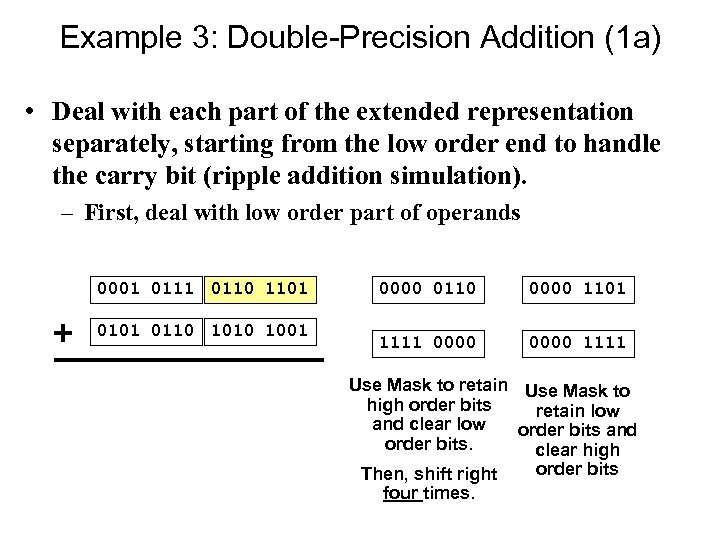
Example 3: Double-Precision Addition (1 a) • Deal with each part of the extended representation separately, starting from the low order end to handle the carry bit (ripple addition simulation). – First, deal with low order part of operands 0001 0110 1101 0110 1001 0000 0110 0000 1101 1111 0000 1111 Use Mask to retain Use Mask to high order bits retain low and clear low order bits and order bits. clear high order bits Then, shift right four times.

Example 3: Double-Precision Addition (1 b) • Deal with each part of the extended representation separately, starting from the low order end to handle the carry bit (ripple addition simulation). – First, deal with low order part of operands 0001 0110 1101 0000 0110 0000 1101 0110 1001 0000 1010 0000 1001 1111 0000 1111 Use Mask to retain and clear bits. Shift high order part right four times.

Example 3: Double-Precision Addition (1 c) • Deal with each part of the extended representation separately, starting from the low order end to handle the carry bit (ripple addition simulation). – First, deal with low order part of operands 0001 0110 1101 0000 0110 0000 1101 0110 1001 0000 1010 0000 1001 0110 0001 0000 0110 1111 0000 Use Masks to retain and clear bits. 0000 1111 Shift high order part right four times.

Example 3: Double-Precision Addition (1 d) • Deal with each part of the extended representation separately, starting from the low order end to handle the carry bit (ripple addition simulation). – First, deal with low order part of operands 0001 0110 1101 0000 0110 0000 1101 0110 1001 0000 1010 0000 1001 0000 0001 0000 0110
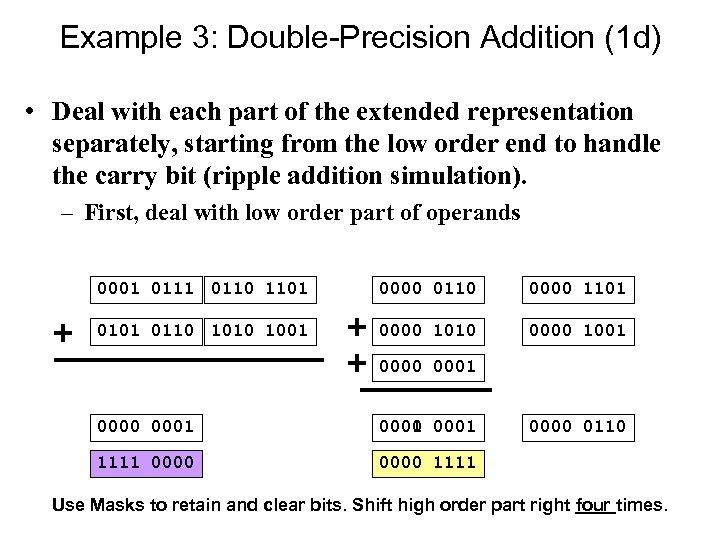
Example 3: Double-Precision Addition (1 d) • Deal with each part of the extended representation separately, starting from the low order end to handle the carry bit (ripple addition simulation). – First, deal with low order part of operands 0001 0110 1101 0000 0110 0000 1101 0110 1001 0000 1010 0000 1001 0000 0001 1111 0000 0110 0000 1111 Use Masks to retain and clear bits. Shift high order part right four times.
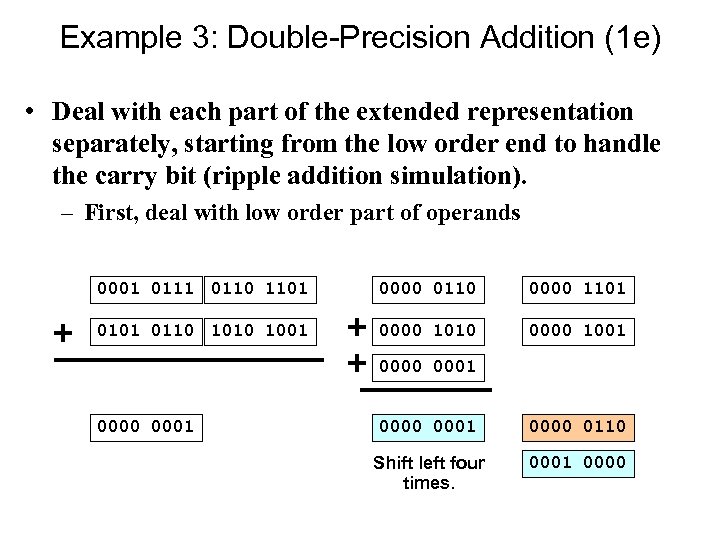
Example 3: Double-Precision Addition (1 e) • Deal with each part of the extended representation separately, starting from the low order end to handle the carry bit (ripple addition simulation). – First, deal with low order part of operands 0001 0110 1101 0000 0110 0000 1101 0110 1001 0000 1010 0000 1001 0000 0001 0000 0110 Shift left four times. 0001 0000

Example 3: Double-Precision Addition (1 f) • Deal with each part of the extended representation separately, starting from the low order end to handle the carry bit (ripple addition simulation). – First, deal with low order part of operands 0001 0110 1101 0000 0110 0000 1101 0110 1001 0000 1010 0000 1001 0000 0001 0110 0001 COMPLEMENT 1111 1001 COMPLEMENT 1110 1001 AND 0000 0110 1111 0000 RECALL LOGIC: A+B = (A+B)’’ = (A’B’)’
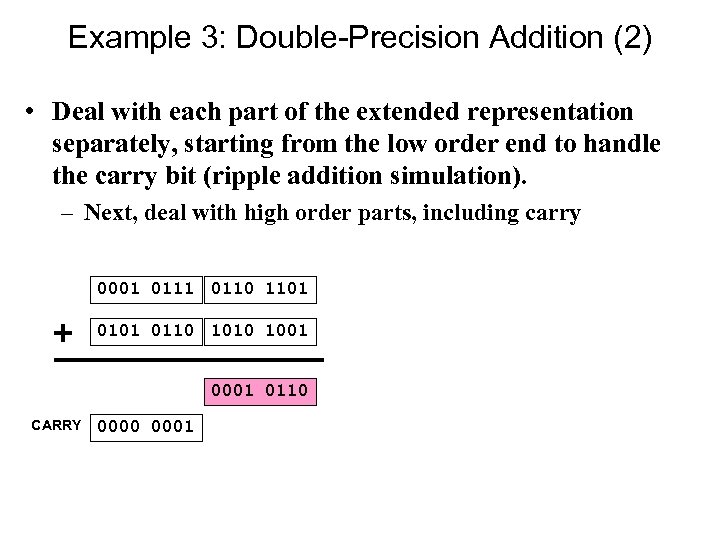
Example 3: Double-Precision Addition (2) • Deal with each part of the extended representation separately, starting from the low order end to handle the carry bit (ripple addition simulation). – Next, deal with high order parts, including carry 0001 0110 1101 0110 1001 0001 0110 CARRY 0000 0001

Example 3: Double-Precision Addition (2) • Deal with each part of the extended representation separately, starting from the low order end to handle the carry bit (ripple addition simulation). – Next, deal with high order parts, including carry 0000 0001 0111 0110 1101 0110 1001 0001 0110 CARRY 0000 0001
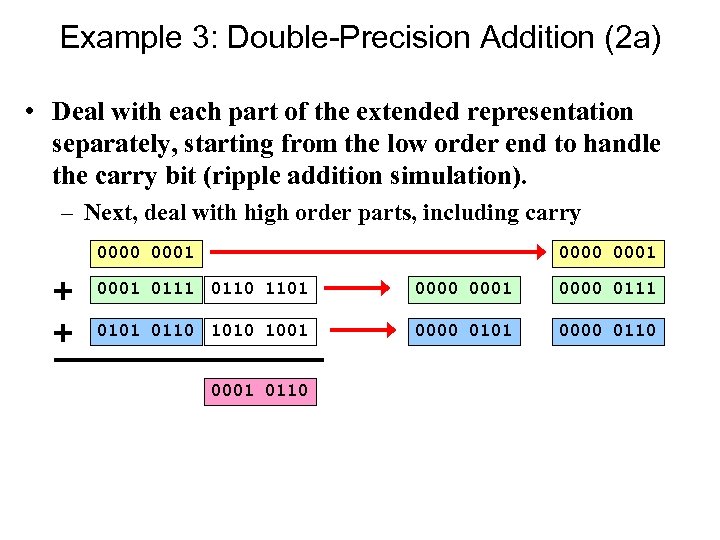
Example 3: Double-Precision Addition (2 a) • Deal with each part of the extended representation separately, starting from the low order end to handle the carry bit (ripple addition simulation). – Next, deal with high order parts, including carry 0000 0001 0110 1101 0000 0001 0000 0111 0101 0110 1001 0000 0110 0001 0110

Example 3: Double-Precision Addition (2 b) • Deal with each part of the extended representation separately, starting from the low order end to handle the carry bit (ripple addition simulation). – Next, deal with high order parts, including carry 0000 0001 0000 0001 0111 0110 1101 0000 0001 0000 0111 0101 0110 1001 0000 0110 0001 0110 0000 1110

Example 3: Double-Precision Addition (2 c) • Deal with each part of the extended representation separately, starting from the low order end to handle the carry bit (ripple addition simulation). – Next, deal with high order parts, including carry 0000 0001 0110 1101 0000 0001 0000 0111 0101 0110 1001 0 0000 0101 0000 0110 0001 0110 0000 0110 Carry Part Sum 0000 1110
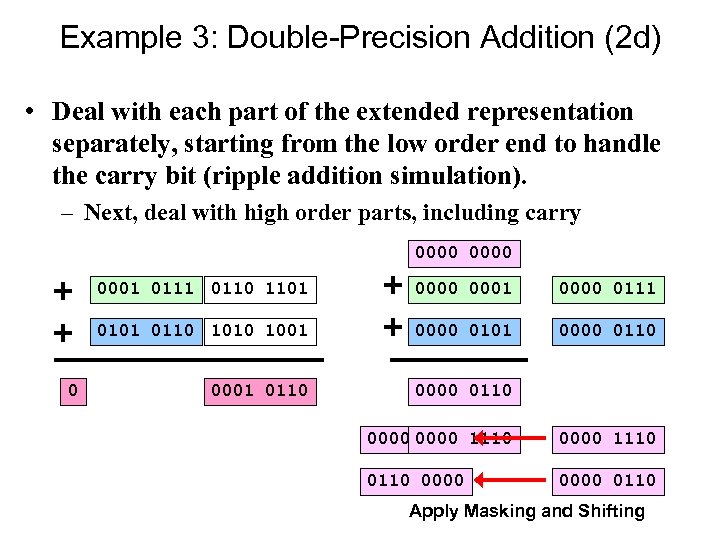
Example 3: Double-Precision Addition (2 d) • Deal with each part of the extended representation separately, starting from the low order end to handle the carry bit (ripple addition simulation). – Next, deal with high order parts, including carry 0000 0001 0110 1101 0000 0111 0101 0110 1001 0 0001 0000 0101 0000 0110 0001 0110 0000 1110 0000 0110 Apply Masking and Shifting
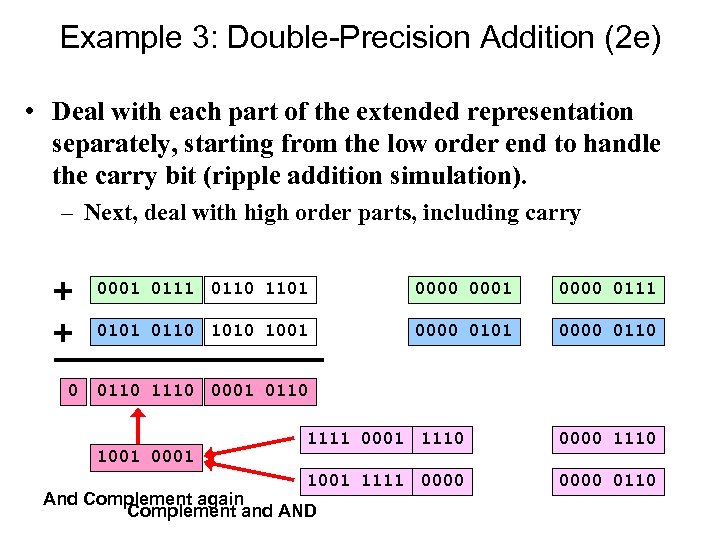
Example 3: Double-Precision Addition (2 e) • Deal with each part of the extended representation separately, starting from the low order end to handle the carry bit (ripple addition simulation). – Next, deal with high order parts, including carry 0001 0110 1101 0000 0111 0101 0110 1001 0 0001 0000 0101 0000 0110 1110 0001 0110 1001 0001 1110 0000 1110 1001 1111 0000 0110 And Complement again Complement and AND
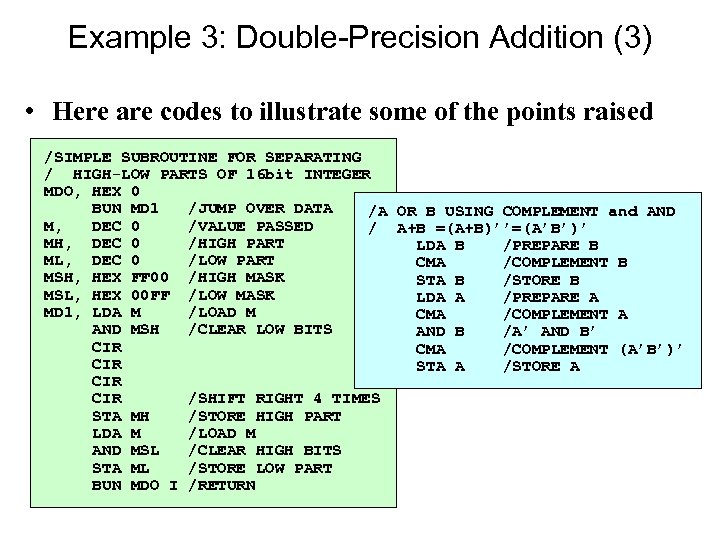
Example 3: Double-Precision Addition (3) • Here are codes to illustrate some of the points raised /SIMPLE SUBROUTINE FOR SEPARATING / HIGH-LOW PARTS OF 16 bit INTEGER MDO, HEX 0 BUN MD 1 /JUMP OVER DATA /A OR B USING COMPLEMENT and AND M, DEC 0 /VALUE PASSED / A+B =(A+B)’’=(A’B’)’ MH, DEC 0 /HIGH PART LDA B /PREPARE B ML, DEC 0 /LOW PART CMA /COMPLEMENT B MSH, HEX FF 00 /HIGH MASK STA B /STORE B MSL, HEX 00 FF /LOW MASK LDA A /PREPARE A MD 1, LDA M /LOAD M CMA /COMPLEMENT A AND MSH /CLEAR LOW BITS AND B /A’ AND B’ CIR CMA /COMPLEMENT (A’B’)’ CIR STA A /STORE A CIR /SHIFT RIGHT 4 TIMES STA MH /STORE HIGH PART LDA M /LOAD M AND MSL /CLEAR HIGH BITS STA ML /STORE LOW PART BUN MDO I /RETURN
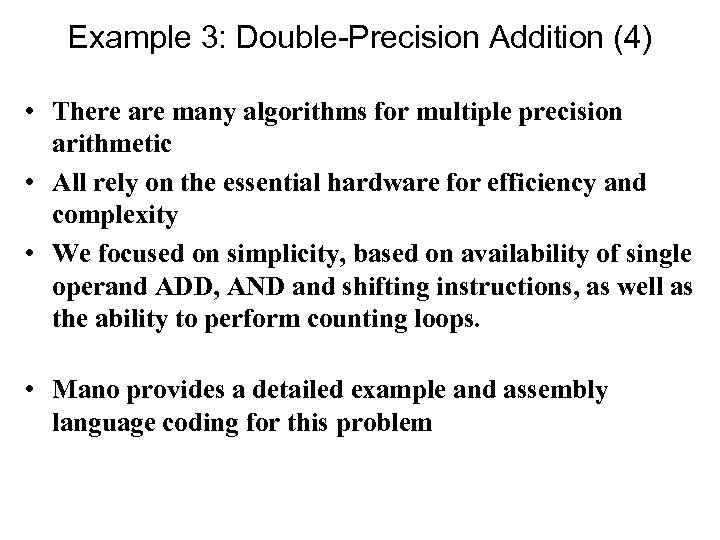
Example 3: Double-Precision Addition (4) • There are many algorithms for multiple precision arithmetic • All rely on the essential hardware for efficiency and complexity • We focused on simplicity, based on availability of single operand ADD, AND and shifting instructions, as well as the ability to perform counting loops. • Mano provides a detailed example and assembly language coding for this problem
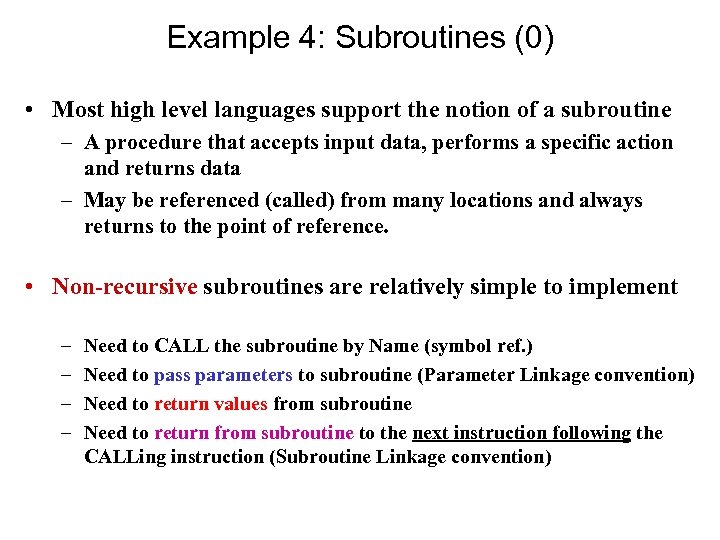
Example 4: Subroutines (0) • Most high level languages support the notion of a subroutine – A procedure that accepts input data, performs a specific action and returns data – May be referenced (called) from many locations and always returns to the point of reference. • Non-recursive subroutines are relatively simple to implement – – Need to CALL the subroutine by Name (symbol ref. ) Need to pass parameters to subroutine (Parameter Linkage convention) Need to return values from subroutine Need to return from subroutine to the next instruction following the CALLing instruction (Subroutine Linkage convention)
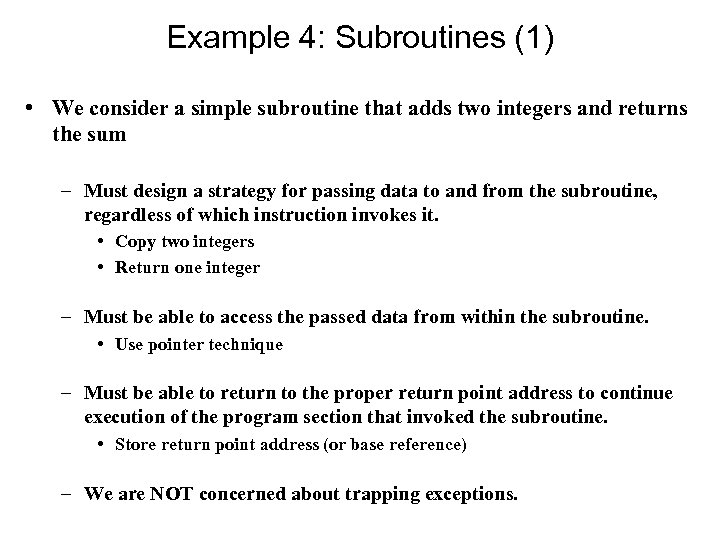
Example 4: Subroutines (1) • We consider a simple subroutine that adds two integers and returns the sum – Must design a strategy for passing data to and from the subroutine, regardless of which instruction invokes it. • Copy two integers • Return one integer – Must be able to access the passed data from within the subroutine. • Use pointer technique – Must be able to return to the proper return point address to continue execution of the program section that invoked the subroutine. • Store return point address (or base reference) – We are NOT concerned about trapping exceptions.

Example 4: Subroutines (2) • First, we consider the issues of invoking (calling) the subroutine – Preparing the values (parameters) • A responsibility of the programmer • For high level languages this is accomplished by the compiler – Passing control to the subroutine • Must ensure that the return address is specified • Mano provides this using the BSA instruction • BSA constrains the approach to subroutine design and use RTV, PM 1, PM 2, RPA, . . LDA STA BSA DEC DEC LDA. . . X PM 1 Y PM 2 SUB 0 0 0 RTV. /PREPARE INPUT DATA / USING STACK / BASED / STRUCTURE /JUMP TO SUBROUTINE /RETURN VALUE /FIRST PARAMETER VALUE /NEXT PARAMETER VALUE /RETURN POINT ADDRESS Choose a data structure based on number and type of data. Locate the data structure at the address in PC when BSA is executed. This address is passed to the subroutine.
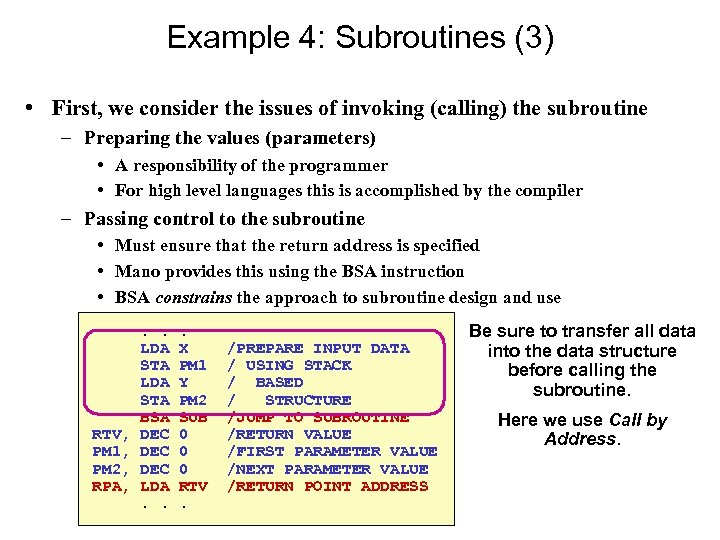
Example 4: Subroutines (3) • First, we consider the issues of invoking (calling) the subroutine – Preparing the values (parameters) • A responsibility of the programmer • For high level languages this is accomplished by the compiler – Passing control to the subroutine • Must ensure that the return address is specified • Mano provides this using the BSA instruction • BSA constrains the approach to subroutine design and use RTV, PM 1, PM 2, RPA, . . LDA STA BSA DEC DEC LDA. . . X PM 1 Y PM 2 SUB 0 0 0 RTV. /PREPARE INPUT DATA / USING STACK / BASED / STRUCTURE /JUMP TO SUBROUTINE /RETURN VALUE /FIRST PARAMETER VALUE /NEXT PARAMETER VALUE /RETURN POINT ADDRESS Be sure to transfer all data into the data structure before calling the subroutine. Here we use Call by Address.

Example 4: Subroutines (4) • First, we consider the issues of invoking (calling) the subroutine – Preparing the values (parameters) • A responsibility of the programmer • For high level languages this is accomplished by the compiler – Passing control to the subroutine • Must ensure that the return address is specified • Mano provides this using the BSA instruction • BSA constrains the approach to subroutine design and use RTV, PM 1, PM 2, RPA, . . LDA STA BSA DEC DEC LDA. . . X PM 1 Y PM 2 SUB 0 0 0 RTV. /PREPARE INPUT DATA / USING STACK / BASED / STRUCTURE /JUMP TO SUBROUTINE /RETURN VALUE /FIRST PARAMETER VALUE /NEXT PARAMETER VALUE /RETURN POINT ADDRESS Call the subroutine – pass control using BSA. It is assumed that the programmer has correctly implemented the return procedure and has provided the return value in the proper location.
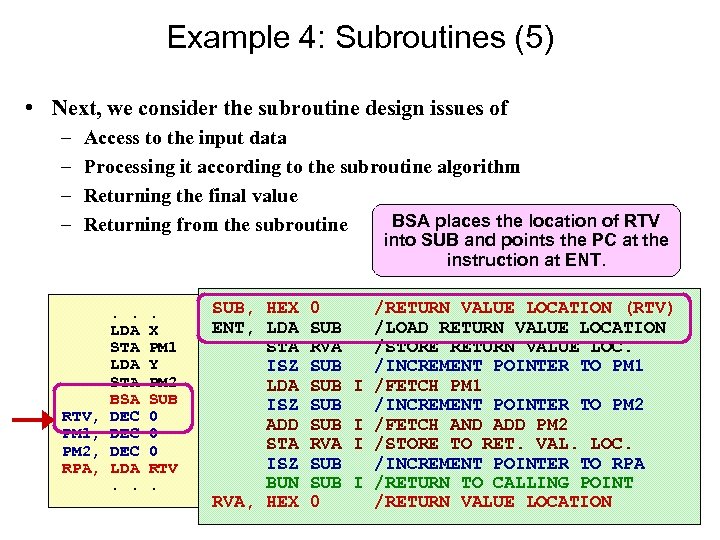
Example 4: Subroutines (5) • Next, we consider the subroutine design issues of – – Access to the input data Processing it according to the subroutine algorithm Returning the final value BSA places the location of RTV Returning from the subroutine RTV, PM 1, PM 2, RPA, into SUB and points the PC at the instruction at ENT. . . LDA STA BSA DEC DEC LDA. . . X PM 1 Y PM 2 SUB 0 0 0 RTV. SUB, HEX 0 /RETURN VALUE LOCATION (RTV) ENT, LDA SUB /LOAD RETURN VALUE LOCATION /PREPARE INPUT DATA /STORE RETURN VALUE LOC. / USING STA RVA STACK / BASED ISZ SUB /INCREMENT POINTER TO PM 1 / STRUCTURE LDA SUB I /FETCH PM 1 /JUMP TO SUBROUTINE ISZ SUB /INCREMENT POINTER TO PM 2 /RETURN VALUE ADD SUB I /FETCH AND ADD PM 2 /FIRST PARAMETER VALUE STA RVA I /STORE TO RET. VAL. LOC. /NEXT PARAMETER VALUE /INCREMENT POINTER TO RPA /RETURN ISZ SUB POINT ADDRESS BUN SUB I /RETURN TO CALLING POINT RVA, HEX 0 /RETURN VALUE LOCATION

Example 4: Subroutines (6) • Next, we consider the subroutine design issues of – – Access to the input data Processing it according to the subroutine algorithm Returning the final value Returning from the subroutine It is often a good idea to store the return address locally. RTV, PM 1, PM 2, RPA, . . LDA STA BSA DEC DEC LDA. . . X PM 1 Y PM 2 SUB 0 0 0 RTV. SUB, HEX 0 /RETURN VALUE LOCATION (RTV) ENT, LDA SUB /LOAD RETURN VALUE LOCATION /PREPARE INPUT DATA /STORE RETURN VALUE LOC. / USING STA RVA STACK / BASED ISZ SUB /INCREMENT POINTER TO PM 1 / STRUCTURE LDA SUB I /FETCH PM 1 /JUMP TO SUBROUTINE ISZ SUB /INCREMENT POINTER TO PM 2 /RETURN VALUE ADD SUB I /FETCH AND ADD PM 2 /FIRST PARAMETER VALUE STA RVA I /STORE TO RET. VAL. LOC. /NEXT PARAMETER VALUE /INCREMENT POINTER TO RPA /RETURN ISZ SUB POINT ADDRESS BUN SUB I /RETURN TO CALLING POINT RVA, HEX 0 /RETURN VALUE LOCATION
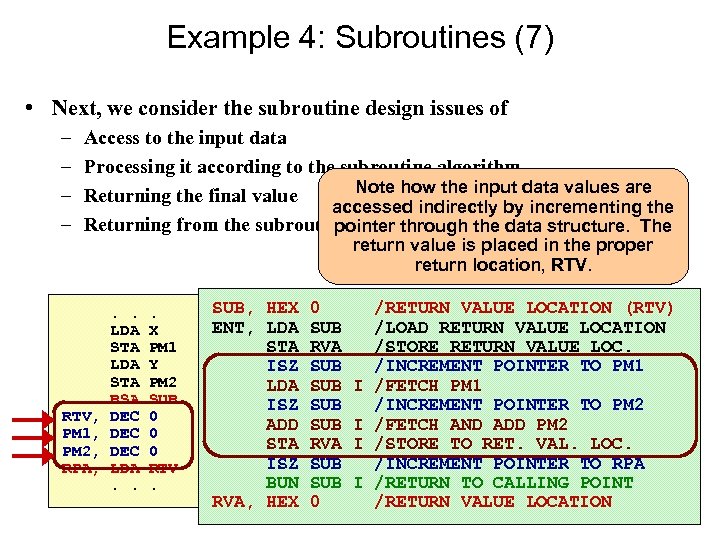
Example 4: Subroutines (7) • Next, we consider the subroutine design issues of – – Access to the input data Processing it according to the subroutine algorithm Note how the input data values are Returning the final value accessed indirectly by incrementing the Returning from the subroutine pointer through the data structure. The return value is placed in the proper return location, RTV, PM 1, PM 2, RPA, . . LDA STA BSA DEC DEC LDA. . . X PM 1 Y PM 2 SUB 0 0 0 RTV. SUB, HEX 0 /RETURN VALUE LOCATION (RTV) ENT, LDA SUB /LOAD RETURN VALUE LOCATION /PREPARE INPUT DATA /STORE RETURN VALUE LOC. / USING STA RVA STACK / BASED ISZ SUB /INCREMENT POINTER TO PM 1 / STRUCTURE LDA SUB I /FETCH PM 1 /JUMP TO SUBROUTINE ISZ SUB /INCREMENT POINTER TO PM 2 /RETURN VALUE ADD SUB I /FETCH AND ADD PM 2 /FIRST PARAMETER VALUE STA RVA I /STORE TO RET. VAL. LOC. /NEXT PARAMETER VALUE /INCREMENT POINTER TO RPA /RETURN ISZ SUB POINT ADDRESS BUN SUB I /RETURN TO CALLING POINT RVA, HEX 0 /RETURN VALUE LOCATION
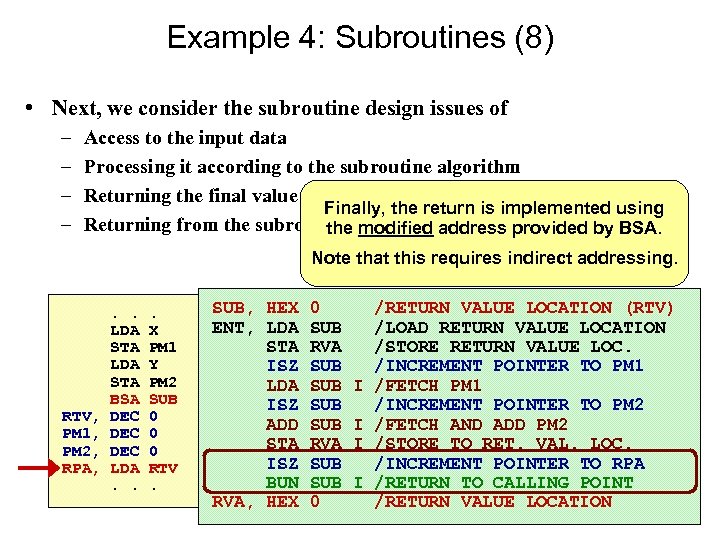
Example 4: Subroutines (8) • Next, we consider the subroutine design issues of – – Access to the input data Processing it according to the subroutine algorithm Returning the final value Finally, the return is implemented using Returning from the subroutine modified address provided by BSA. the Note that this requires indirect addressing. RTV, PM 1, PM 2, RPA, . . LDA STA BSA DEC DEC LDA. . . X PM 1 Y PM 2 SUB 0 0 0 RTV. SUB, HEX 0 /RETURN VALUE LOCATION (RTV) ENT, LDA SUB /LOAD RETURN VALUE LOCATION /PREPARE INPUT DATA /STORE RETURN VALUE LOC. / USING STA RVA STACK / BASED ISZ SUB /INCREMENT POINTER TO PM 1 / STRUCTURE LDA SUB I /FETCH PM 1 /JUMP TO SUBROUTINE ISZ SUB /INCREMENT POINTER TO PM 2 /RETURN VALUE ADD SUB I /FETCH AND ADD PM 2 /FIRST PARAMETER VALUE STA RVA I /STORE TO RET. VAL. LOC. /NEXT PARAMETER VALUE /INCREMENT POINTER TO RPA /RETURN ISZ SUB POINT ADDRESS BUN SUB I /RETURN TO CALLING POINT RVA, HEX 0 /RETURN VALUE LOCATION
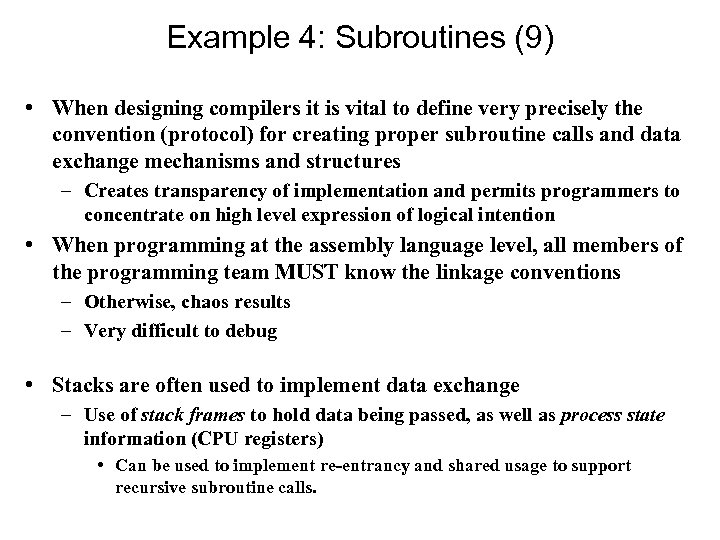
Example 4: Subroutines (9) • When designing compilers it is vital to define very precisely the convention (protocol) for creating proper subroutine calls and data exchange mechanisms and structures – Creates transparency of implementation and permits programmers to concentrate on high level expression of logical intention • When programming at the assembly language level, all members of the programming team MUST know the linkage conventions – Otherwise, chaos results – Very difficult to debug • Stacks are often used to implement data exchange – Use of stack frames to hold data being passed, as well as process state information (CPU registers) • Can be used to implement re-entrancy and shared usage to support recursive subroutine calls.
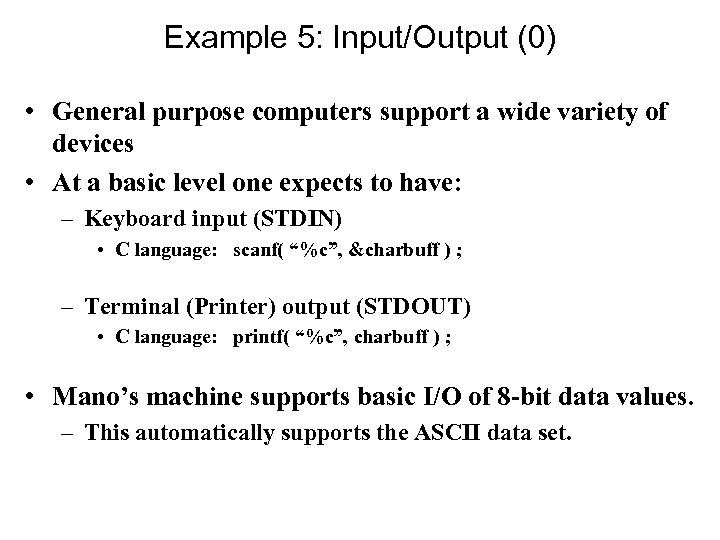
Example 5: Input/Output (0) • General purpose computers support a wide variety of devices • At a basic level one expects to have: – Keyboard input (STDIN) • C language: scanf( “%c”, &charbuff ) ; – Terminal (Printer) output (STDOUT) • C language: printf( “%c”, charbuff ) ; • Mano’s machine supports basic I/O of 8 -bit data values. – This automatically supports the ASCII data set.
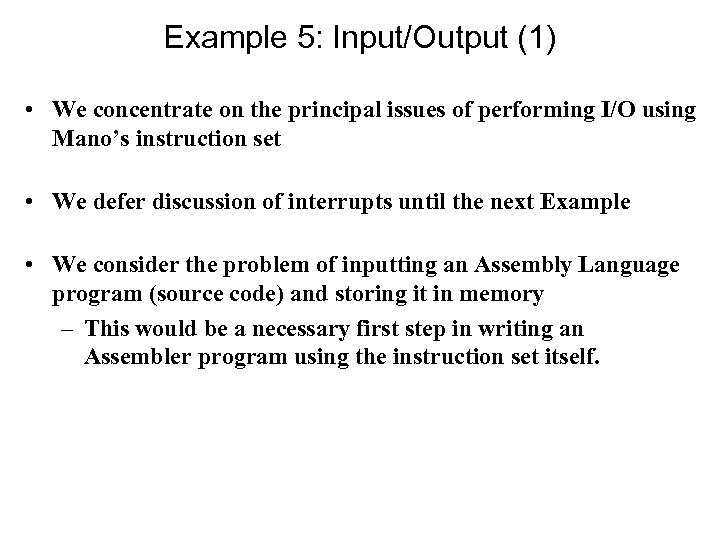
Example 5: Input/Output (1) • We concentrate on the principal issues of performing I/O using Mano’s instruction set • We defer discussion of interrupts until the next Example • We consider the problem of inputting an Assembly Language program (source code) and storing it in memory – This would be a necessary first step in writing an Assembler program using the instruction set itself.
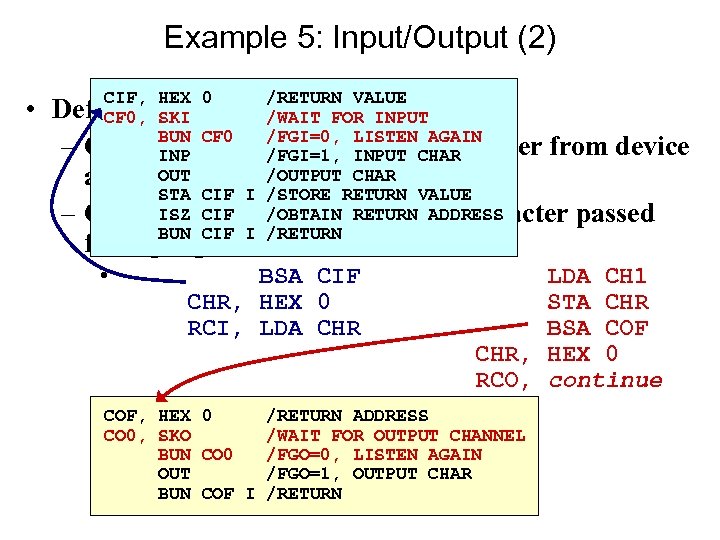
Example 5: Input/Output (2) • CIF, HEX 0 /RETURN VALUE Define two subroutines FOR INPUT CF 0, SKI /WAIT – CIF – BUN CF 0 /FGI=0, of one. CHAR performs/FGI=1, LISTEN character from device input INPUT AGAIN INP OUT /OUTPUT CHAR and returns it to program STA CIF I /STORE RETURN VALUE – COF –ISZ CIF /OBTAIN RETURN ADDRESS performs output of one character passed BUN CIF I /RETURN from program to device • BSA CIF CHR, HEX 0 RCI, LDA CHR COF, HEX 0 CO 0, SKO BUN CO 0 OUT BUN COF I LDA CH 1 STA CHR BSA COF CHR, HEX 0 RCO, continue /RETURN ADDRESS /WAIT FOR OUTPUT CHANNEL /FGO=0, LISTEN AGAIN /FGO=1, OUTPUT CHAR /RETURN
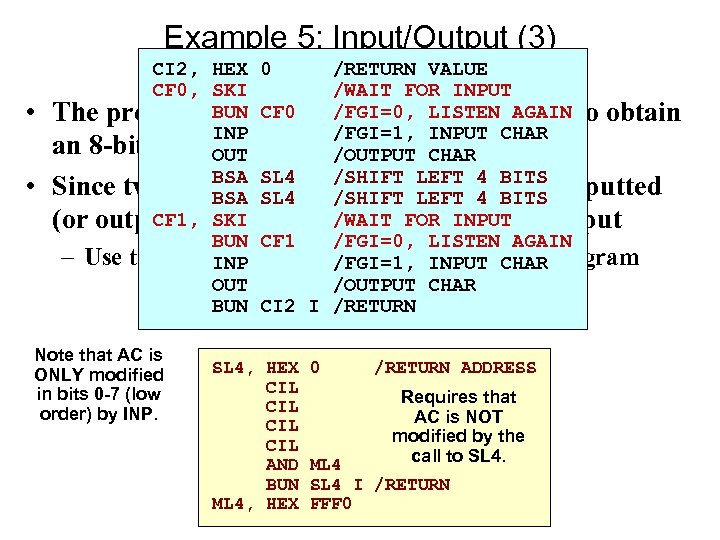
Example 5: Input/Output (3) • • CI 2, HEX 0 /RETURN VALUE CF 0, SKI /WAIT FOR INPUT The previous BUN CF 0 used a 16 -bit storage to obtain example /FGI=0, LISTEN AGAIN INP /FGI=1, INPUT CHAR an 8 -bit quantity OUT /OUTPUT CHAR BSA SL 4 /SHIFT Since two, or BSA SL 4 /SHIFT LEFT usually inputted more, characters. LEFT 4 BITS are 4 BITS CF 1, SKI (or outputted), we treat/WAIT FORof 2 -char Input the case INPUT BUN CF 1 /FGI=0, LISTEN AGAIN – Use the AC to transfer data back to calling program INP /FGI=1, INPUT CHAR OUT /OUTPUT CHAR BUN CI 2 I /RETURN Note that AC is ONLY modified in bits 0 -7 (low order) by INP. SL 4, HEX CIL CIL AND BUN ML 4, HEX 0 /RETURN ADDRESS Requires that AC is NOT modified by the call to SL 4. ML 4 SL 4 I /RETURN FFF 0
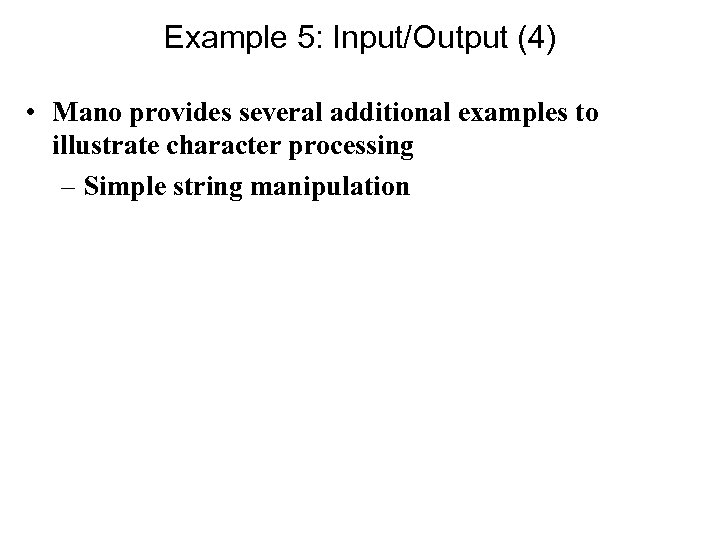
Example 5: Input/Output (4) • Mano provides several additional examples to illustrate character processing – Simple string manipulation

Example 6: Interrupt Handling (0) • The needs for interrupts arise in different contexts – Trapping exceptions from instructions • Integer addition/subtraction overflow • Divide by zero • Addressing/Protection – Responding to events (event handling) • Clock cycles for scheduled O/S operations • Listening to communications ports • Communicating with Input/Output devices • Mano’s machine implements an interrupt capability to enable asynchronous I/O – The basic idea can be extended to handling of a wide variety of interrupts
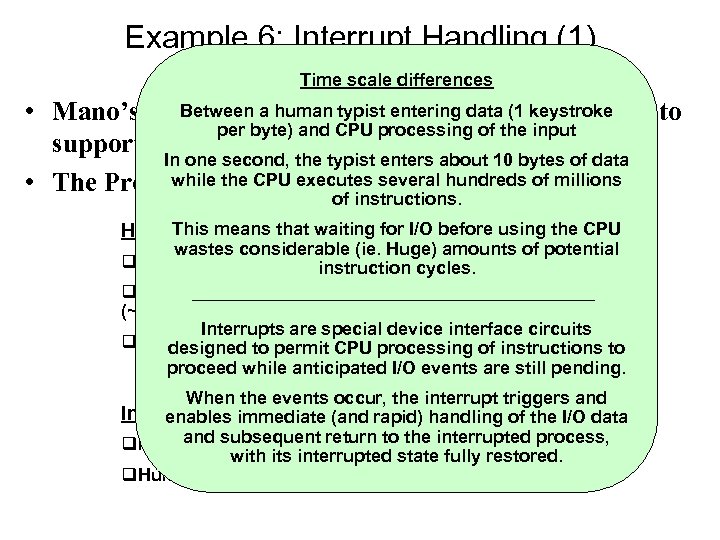
Example 6: Interrupt Handling (1) Time scale differences Between a human typist entering data (1 capability to • Mano’s machine implements an interruptkeystroke per byte) and CPU processing of the input support asynchronous I/O In one second, the typist enters about 10 bytes of data while • The Problem: the CPU executes several hundreds of millions of instructions. This Performance Rates Hardware means that waiting for I/O before using the CPU wastes considerable (ie. Huge) amounts of potential q. Bus 800 Mbps = 100 instruction cycles. MBps q. CPU 2 GHz ~ 1 billion instruction timing units per second (~200 MIPS) Interrupts are special device interface circuits q. Network 1 MBps to 100 MBps designed to permit CPU processing of instructions to proceed while anticipated I/O events are still pending. When the events occur, the interrupt triggers and Information Production Rates handling of the I/O data enables immediate (and rapid) and Disk 1 KBps to 1 MBps q. Magnetic subsequent return to the interrupted process, with its interrupted state fully restored. q. Human Typist 10 Bps
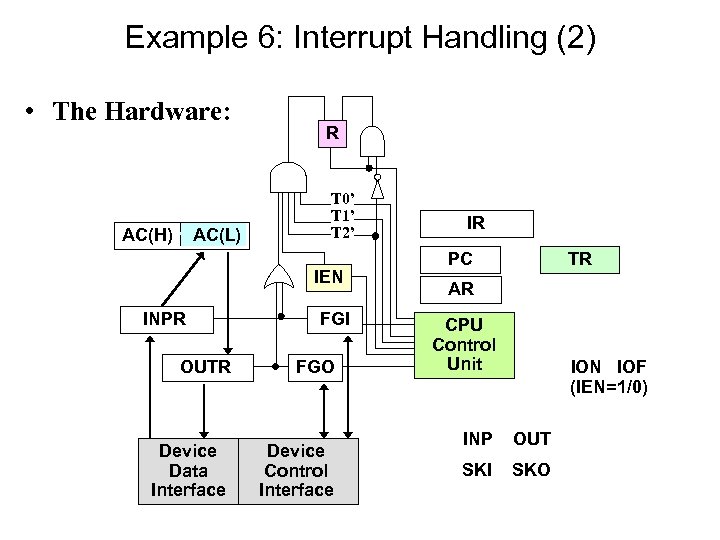
Example 6: Interrupt Handling (2) • The Hardware: AC(H) AC(L) R T 0’ T 1’ T 2’ IEN INPR FGI OUTR FGO Device Data Interface Device Control Interface IR PC TR AR CPU Control Unit ION IOF (IEN=1/0) INP OUT SKI SKO

Example 6: Interrupt Handling (3) • The Hardware: AC(H) AC(L) R T 0’ T 1’ T 2’ IEN INPR OUTR FGI FGO Instructions should be executed atomically! IR PC TR AR CPU Control Unit a) T 0’ T 1’ T 2’ (IEN) (FGI+FGO) : R = 1 b) NORMAL R’ T 0 : AR = PC R’ T 1 : IR = M[AR] , PC = PC + 1 R’ T 2 : {D 0. . D 7} = DEC( IR(12. . 14) ) , AR = IR(0. . 11), I = IR(15) c) Device R T 0 : AR = 0 , Control TR = PC Data RInterface =Interface 0 T 1 : M[AR] TR , PC = INTERRUPT ! R T 2 : PC = PC + 1 , IEN = 0 , R = 0 , SC = 0
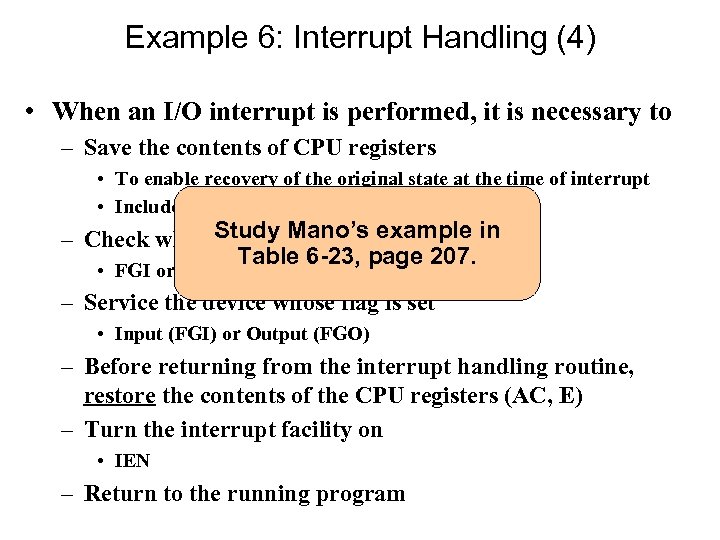
Example 6: Interrupt Handling (4) • When an I/O interrupt is performed, it is necessary to – Save the contents of CPU registers • To enable recovery of the original state at the time of interrupt • Includes: AC, E – Check which. Study Mano’s example in flag is set Table 6 -23, page 207. • FGI or FGO – Service the device whose flag is set • Input (FGI) or Output (FGO) – Before returning from the interrupt handling routine, restore the contents of the CPU registers (AC, E) – Turn the interrupt facility on • IEN – Return to the running program
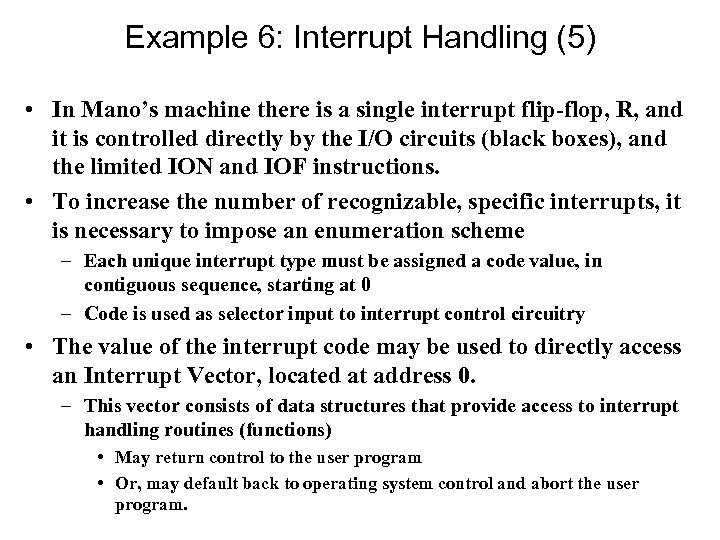
Example 6: Interrupt Handling (5) • In Mano’s machine there is a single interrupt flip-flop, R, and it is controlled directly by the I/O circuits (black boxes), and the limited ION and IOF instructions. • To increase the number of recognizable, specific interrupts, it is necessary to impose an enumeration scheme – Each unique interrupt type must be assigned a code value, in contiguous sequence, starting at 0 – Code is used as selector input to interrupt control circuitry • The value of the interrupt code may be used to directly access an Interrupt Vector, located at address 0. – This vector consists of data structures that provide access to interrupt handling routines (functions) • May return control to the user program • Or, may default back to operating system control and abort the user program.
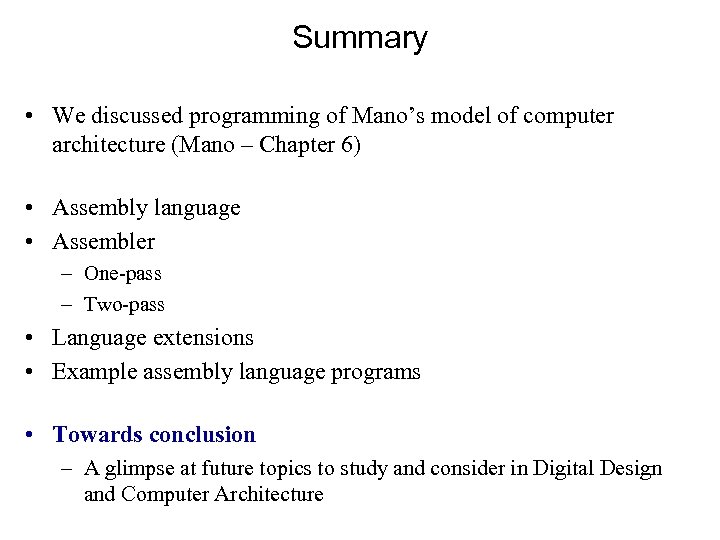
Summary • We discussed programming of Mano’s model of computer architecture (Mano – Chapter 6) • Assembly language • Assembler – One-pass – Two-pass • Language extensions • Example assembly language programs • Towards conclusion – A glimpse at future topics to study and consider in Digital Design and Computer Architecture
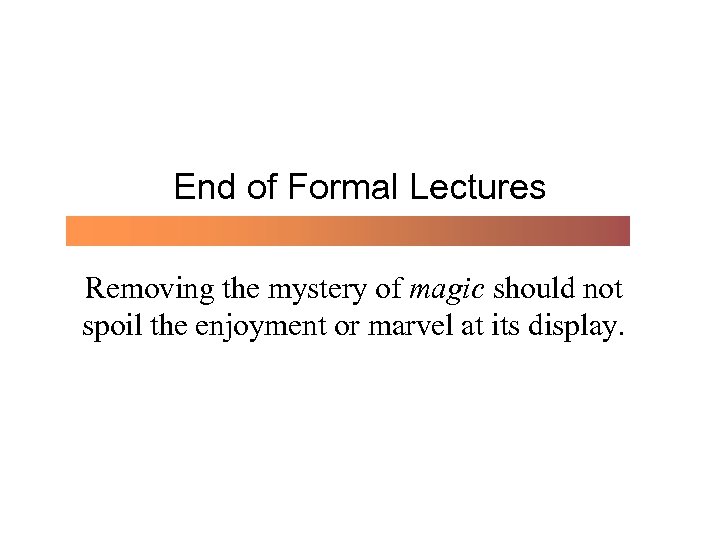
End of Formal Lectures Removing the mystery of magic should not spoil the enjoyment or marvel at its display.

Into the Future • Future topics in – Digital Design • Minimization of logic circuit complexity (Quine-Mc. Cluskey. Petrick) – Computer Architecture • Expanding memory address space • Expanding CPU register set • Extending the instruction set, number of operands, addressing modes • Multiprocessors – – Multi-core processing (inline channel parallelism) SMP – Symmetric Multi-Processing Multiple CPUs, Memories Complex bus architectures • Extending Input and Output capabilities
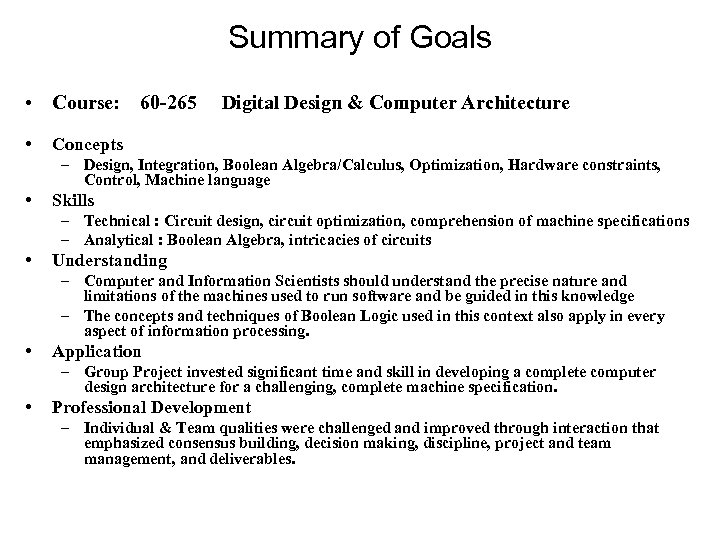
Summary of Goals • Course: 60 -265 • Digital Design & Computer Architecture Concepts – Design, Integration, Boolean Algebra/Calculus, Optimization, Hardware constraints, Control, Machine language • Skills – Technical : Circuit design, circuit optimization, comprehension of machine specifications – Analytical : Boolean Algebra, intricacies of circuits • Understanding – Computer and Information Scientists should understand the precise nature and limitations of the machines used to run software and be guided in this knowledge – The concepts and techniques of Boolean Logic used in this context also apply in every aspect of information processing. • Application – Group Project invested significant time and skill in developing a complete computer design architecture for a challenging, complete machine specification. • Professional Development – Individual & Team qualities were challenged and improved through interaction that emphasized consensus building, decision making, discipline, project and team management, and deliverables.
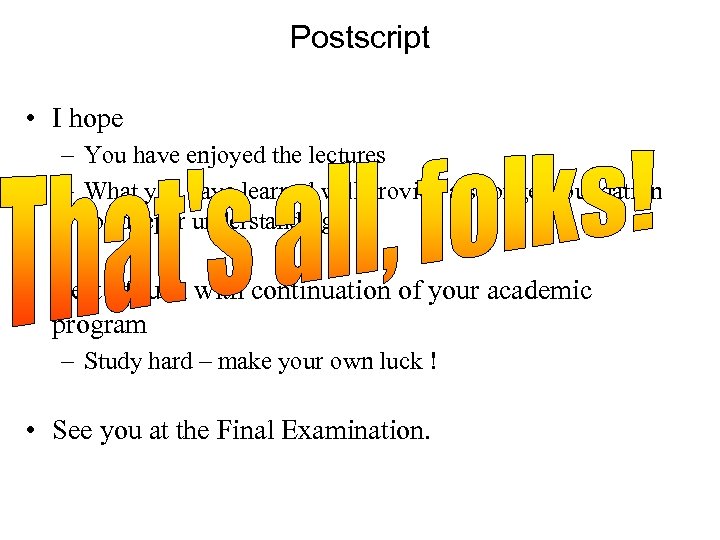
Postscript • I hope – You have enjoyed the lectures – What you have learned will provide a stronger foundation for deeper understanding. • Best of luck with continuation of your academic program – Study hard – make your own luck ! • See you at the Final Examination.
ff97d19782da7054f9b3eae152e76137.ppt